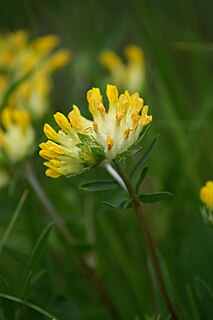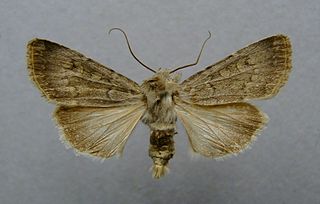
The small blue is a Palearctic butterfly in the family Lycaenidae. Despite its common name, it is not particularly blue. The male has some bluish suffusion at the base of its upper wings but is mostly dark brown like the female. The species can live in colonies of up to several hundred and in its caterpillar stage is cannibalistic.
Woundwort is the common name for several species of plants and may refer to:

Anthyllis is a genus of flowering plants in the legume family Fabaceae. This genus contains both herbaceous and shrubby species and is distributed in Europe, the Middle East and North Africa. The most widespread and familiar species is A. vulneraria, a familiar grassland flower which has also been introduced to New Zealand.

Purn Hill is a 6.1 hectare biological Site of Special Scientific Interest near the village of Bleadon, Somerset, notified in 1990. The site is a small promontory of Carboniferous Limestone projecting southward from the main Mendip ridge.

Anthyllis montana, the mountain kidney vetch, is a species of flowering plant in the family Fabaceae, native to the mountains of Southern Europe and parts of the Alps. Growing to 30 cm (12 in) tall by 60 cm (24 in) broad, it is a clump-forming, woody-based perennial. The leaves are divided into numerous fern-like leaflets, and the white, pink or purple clover-like flower-heads are borne in Spring and Summer. The Latin specific epithet montana refers to mountains or coming from mountains.

West Yatton Down is a 14.4 hectare biological Site of Special Scientific Interest in Wiltshire, notified in 1971.

"The genus Banksia L.f. (Proteaceae)" is a 1981 monograph by Alex George on the taxonomy of the plant genus Banksia. Published by the Western Australian Herbarium as Nuytsia3(3), it presented George's taxonomic arrangement of Banksia, the first major taxonomic revision of the genus since George Bentham published his arrangement in Flora Australiensis in 1870.
British NVC community MC5 is one of the maritime cliff communities in the British National Vegetation Classification system. It is one of five communities categorised as maritime cliff crevice and ledge communities.

Anthyllis vulneraria, the common kidneyvetch, kidney vetch or woundwort is a medicinal plant native to Europe. The name vulneraria means "wound healer".

Kennedia coccinea is a species of flowering plant in the family Fabaceae, endemic to the south-west of Western Australia. It is a low growing trailing shrub or climber which has twining rust-coloured branchlets with rounded leaflets that are about 1.5 cm long and occur in threes. Orange red or scarlet pea flowers are produced in clusters between August and November in its native range.

Euxoa decora is a moth of the family Noctuidae. It is found in southern and central Europe, Morocco, Algeria, the Caucasus, Armenia, Issyk-Kul, Turkey, Iran and Iraq.
Coleophora nubivagella is a moth of the family Coleophoridae. It is found from Germany and Poland to the Pyrenees, Italy, North Macedonia and Romania.

Aproaerema anthyllidella is a moth of the family Gelechiidae. It is found in most of Europe, Kyrgyzstan, Iran and North America.
Bembecia iberica is a moth of the family Sesiidae. It is found in France, Spain, Portugal and Italy and on Corsica and Sardinia.

Bembecia scopigera, the six-belted clearwing or glearwing, is a moth of the family Sesiidae. It is found from central Spain over most of south-western and central Europe, the Balkans, Greece, southern Russia and Ukraine to Turkey.

Erinacea anthyllis, the blue broom, hedgehog plant, or rushy kidney vetch, is a species of flowering plant in the legume family Fabaceae. It is native to stony mountainous places in the Pyrenees, the Mediterranean and Morocco. It is a dwarf, spiny, evergreen shrub growing to a dome shape 30 cm (12 in) tall and wide. It has dense foliage, and lilac coloured pea-like flowers in late spring and early summer.
Polyommatus (Plebicula) sagratrox, the Sierra de la Sagra blue, is a species of butterfly in the family Lycaenidae. It is endemic to Spain in the south-east of the Iberian Peninsula.
Mesorhizobium metallidurans is a gram-negative, aerobic, non-spore-forming bacteria from the genus Mesorhizobium which was isolated from root nodules of Anthyllis vulneraria in the spoil heaps from the heavy metal enriched Laurent le Minier located in the Languedoc in France.

Watts Bank is a 1.9-hectare (4.7-acre) nature reserve south of Lambourn in Berkshire. It is managed by the Berkshire, Buckinghamshire and Oxfordshire Wildlife Trust. It is designated a biological Site of Special Scientific Interest as White Shute.
Scythris siccella is a moth of the family Scythrididae first described by the German entomologist Philipp Christoph Zeller in 1839, found in Europe.













